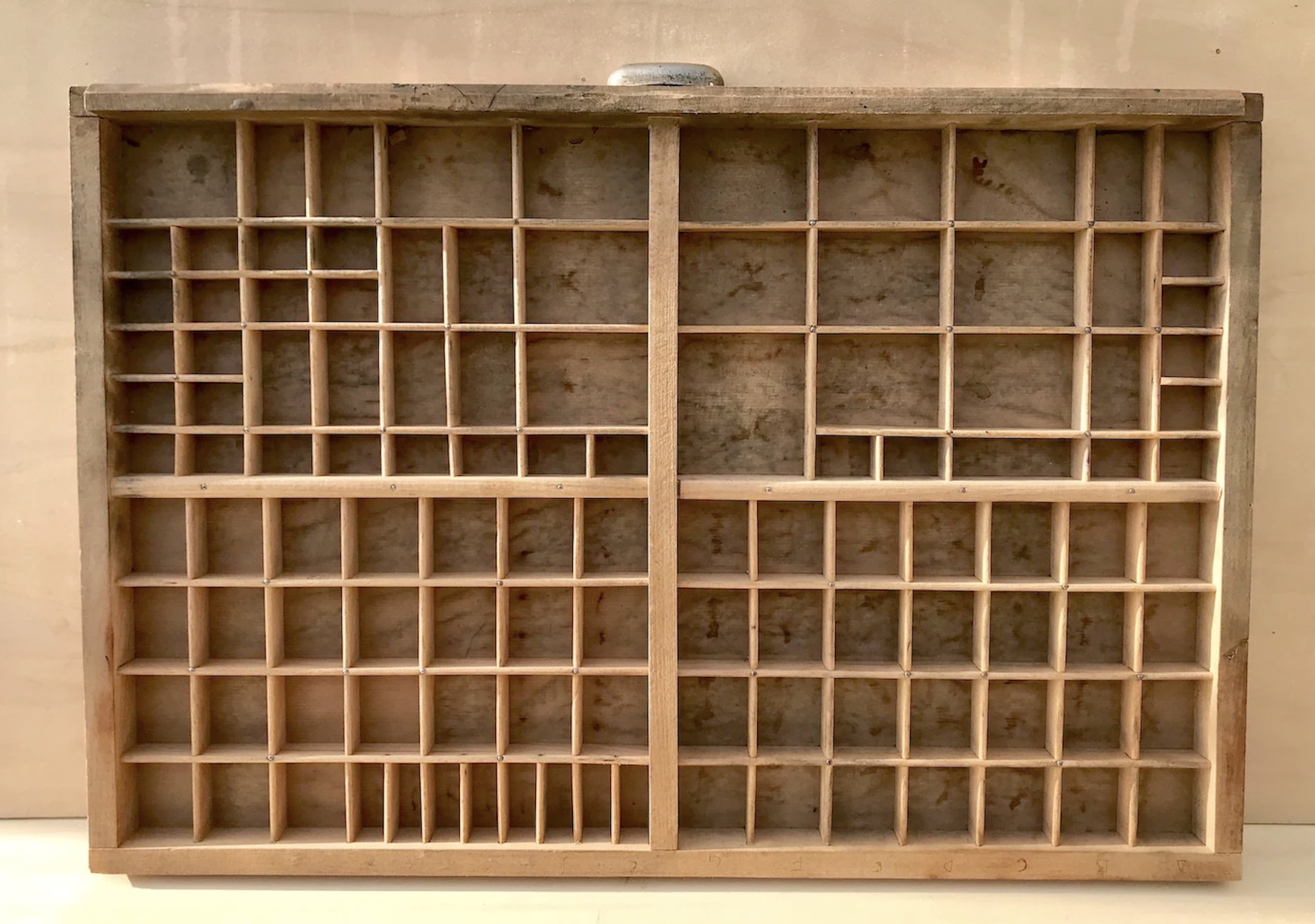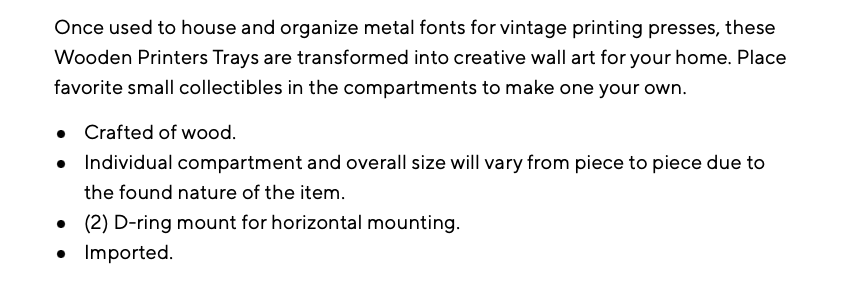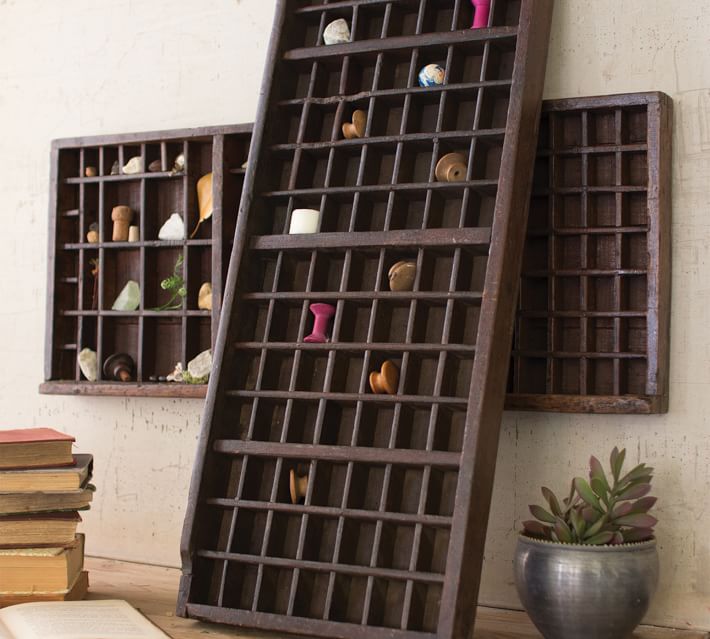Lead in Antiques & Christmas Lights (& Stained Glass Windows & Antique Print Trays) – a video.

Image of an antique print tray found on Etsy
Originally Published: December 10, 2013
Updated: March 13, 2022 – Sunday
Below is a video that is a scene from an early cut of my documentary feature film (that was one of the many, many fun scenes that we eventually had to cut from the film to reduce the run time to something reasonably aligned with industry standards!). In the clip I start out talking about Lead in antiques and close with Lead in Christmas lights; please watch and share. Thank you!
NOTE about vintage /antique print drawers / wooden Lead type storage trays
Print trays are discussed briefly in this video (as there happened to be one in the window of that antique shop — which in the video we are perusing, looking for examples of things that often have unsafe levels of Lead). Print trays are the antique drawers of “print” storage cabinets — from when printers employed LEAD (solid LEAD) type as the standard medium for printing newspapers, books, and other printed materials. Each chunk of Lead was formed into an individual letter – of different sizes and type faces [a complete set of the available variations of that type face (e.g. bold, italics, light, heavy, condensed, etc.) comprised a “font“] and these cabinets were built of shallow sturdy wooden trays to hold all those sets of heavy Lead type. To reiterate, the print letters stored in these drawers were made of solid Lead.
One of the earliest professions that was noted (in the United States, at least) to cause acute Lead-poisoning of the people who worked in that industry was the printing industry. Benjamin Franklin wrote about the problem of Lead-poisoning impacting typesetters, in a letter from the 1700s [July 31, 1786, to be precise] You can read that letter in full here – link.
Wood is (unfortunately, in this case) very porous. Chunks of solid Lead stored together in a drawer will create significant levels of Lead dust when they move about (which would happen simply with the act of opening and closing these drawers full of type.) As a result, the woodgrain of these drawers is nearly always heavily contaminated – saturated – with high levels of micro-particulate (invisible) Lead dust from decades (or even a century or more) of active service storing and organizing movable Lead type in print shops!
Can you test these drawers yourself at home?
In most cases, the Lead dust level is so high, that these antique print drawers / type drawers will actually test positive with a reactive-agent swab home test kit (you can see what those look like here — oh, and do not buy off-brand versions of these products, as they quite regularly do not work)!
It is important to realize however that even if your drawer does not test positive (using a reactive agent home test kit), it can still contain significant (and very dangerous) amounts of Lead embedded in the wood grain — at levels far above a level that might ever be considered remotely safe for a child! You can read more about how much Lead in dust it takes to poison a child on this link.
When tested with an XRF instrument (you can read more about what that is here, but – in short, it is the instrument used by the United States Consumer Product Safety Commission [CPSC] to screen consumer goods for heavy metals to determine if an item is safe for children to use) these drawers often test positive for Lead in the range of 1,000 to 2,000 ppm. This is quite alarming — as the amount of Lead that is considered toxic (and absolutely unsafe in items intended for use by children) is anything 90 ppm Lead and above (as detected using XRF testing methods). This is doubly-concerning, because parents who are not aware of this Lead exposure hazard often use these trays to store curios and small toys in their children’s rooms (frequently keeping these trays displayed at “child-height”, which would:
- potentially significantly contaminate any items stored in these cases with micro-particulate (invisible) Lead dust, and
- encourage children to play with the objects stored in these cases
Takeaway on the Vintage / Antique Type Trays
- Do not ever use a vintage / antique print tray for storage of items intended for use by children.
- If you have/had one of these trays in your child’s room for storing small toys, please consider asking your doctor for a Blood Lead Level test for that child, if they have not had a Lead test recently [You can read more about that on this link here], and they should be tested on an “urgent” basis (this WEEK, if at all possible) — tell your doctor you had a potential exposure incident from a toy.
- If you cannot be dissuaded from wanting to keep one of these in your home, please keep it out of reach of children, and coat it in a thick layer (front and back and in all the nooks and crannies) of a heavy duty sealant (such as polyurethane or similar). The company EarthPaint makes a cashew-based marine grade urethane that might be an appropriate natural alternative to some of the more toxic sealant products.
- EVEN if these are coated with a sealant, they should still not be used by children or for storage of items intended for use by children because the sealant layer can wear over time (especially if a child is moving things in and out of the cubbies of these drawers, items that might scratch or abrade a sealant) and the Lead Levels are so high that a worn surface would be an exposure concern.
- If you have one of these vintage/antique print trays in your home, bring a contractor garbage bag TO the item (don’t take it down and bring the item to the garbage bag — as the Lead dust could possibly contaminate any areas you carry it through – depending on the Lead levels and condition of the drawer.)
- Put the drawer (and all of the items in the drawer) straight into the contractor garbage bag.
- Put the entire thing in your garage or some other storage area where your children cannot get to it.
- Take your time to meticulously clean each item that was stored in the drawer if (in fact) you determine that is something worth doing.
- Cleaning of items should be done with surfactant-containing cleaners [necessary for picking up the inherently sticky/clingy Lead dust] — NOT “natural” cleaning solutions, or vinegar, etc.
- You can read more about how to clean Lead dust from toys here.
IMPORTANT POINT: Just because something is sold by a name brand retailer (like Pottery Barn) does NOT mean it is safe. The image below is the text for Pottery Barn’s listing in which they are selling these old print drawers. Pottery Barn is on my “Do Not Shop At” list (you can read that post here.)
… and here’s the image from Pottery Barn’s website
Continue reading below the image

Please watch the short video below for more information.
If you would like to make a contribution to support my independent consumer goods testing and childhood lead poisoning prevention advocacy work, please click here! Thank you! For those new to this website and this work, please check out this post that discusses the business model of Lead Safe Mama, LLC.
For those new to this website:
Tamara Rubin is a Federal-award-winning independent advocate for consumer goods safety and a documentary filmmaker. She is also a mother of Lead-poisoned children. Tamara’s sons were acutely Lead-poisoned in August of 2005. She began testing consumer goods for toxicants in 2009 and was the parent-advocate responsible for finding Lead in the popular fidget spinner toys in 2017. Tamara uses XRF testing (a scientific method used by the U.S. Consumer Product Safety Commission) to test consumer goods for toxicants (specifically heavy metals), including Lead, Cadmium, Mercury, Antimony, and Arsenic. All test results reported on this website are science-based, accurate, and replicable. Items are tested multiple times, to confirm the test results for each component tested. Please click through to this link to learn more about the testing methodology used for the test results discussed and reported on this website.
Never Miss an Important Article Again!
Join our Email List












Tin Christmas Tree Star- Can of 20 – Handmade Tin Christmas Tree Ornaments made in Canada
(Brand: Pietersma Tinworks) is a non toxic, simple alternative to antique Christmas ornaments. Greg Pietersma also crafts icicles and other items like tealights. These reasonably priced items sell out very fast. Even someone who doesn’t celebrate Christmas would enjoy decorating with his handmade items. What he makes can be purchased on Amazon. (good for your finances) 🙂
Thank you for everything you do. I appreciate you and your hard work.
Thanks a lot for this valuable information. I came across this and a friend brought me one when I got into stationary stuff. It’s pretty heavily advertised in stationary community btw… I’m not sure if it’s effect on adults, but considering its effect on children I could imagine it’s also not that good for adults. I decided to say goodbye to it for good.
Very sad that this wood can’t be cleaned for using, but what could one do…
Thanks for making this documentary